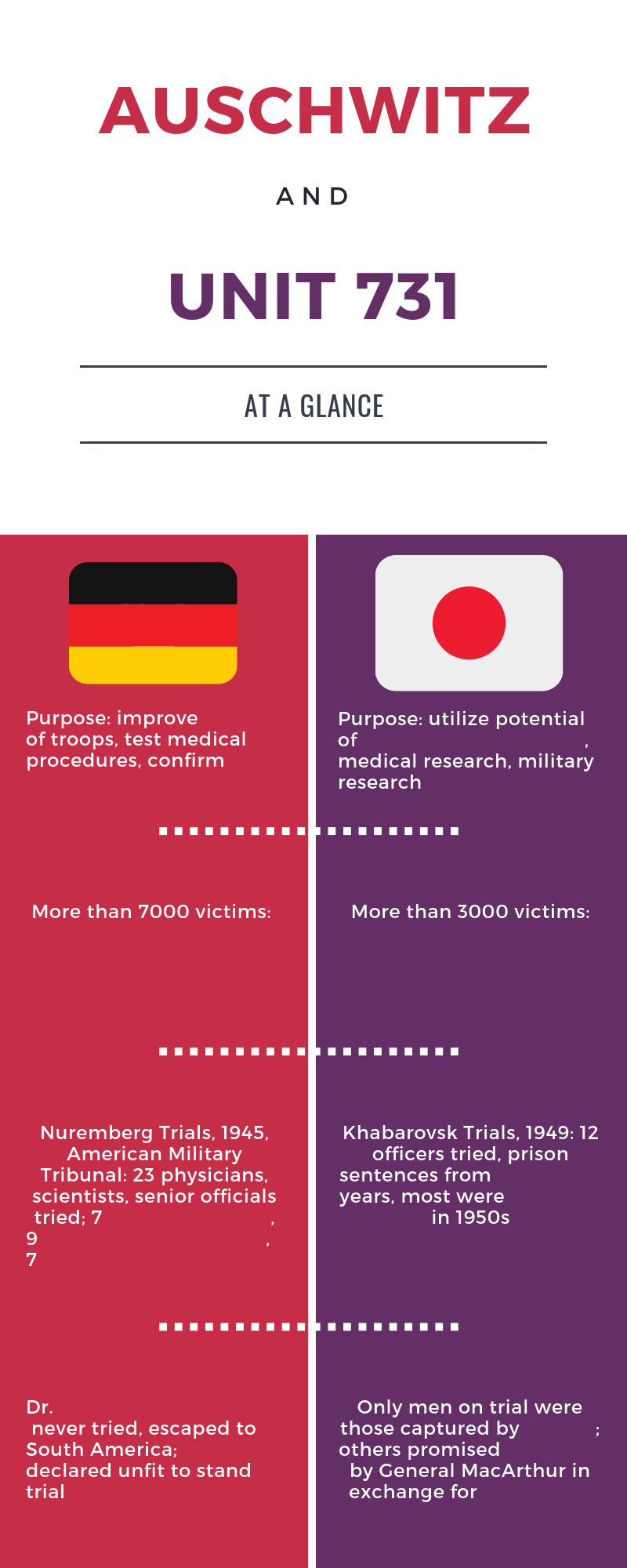Europe
Unit 731 and Auschwitz
Purpose: This activity introduces students to Unit 731 and its use as a Japanese biological warfare research facility, as well as the reason for decades of silence and lack of acknowledgment. Students are asked to consider similar medical experimentation in Nazi Germany and compare how the perpetrators were treated in post-WWII trials.
Objective: Students will view and listen to a slideshow lecture about Unit 731 and be asked to fill out a worksheet afterwards comparing Japanese and German medical research facilities. They will discuss the reasons as to why there was a radical difference in prosecution and punishment.
California Social Studies Content Standard: 10.8 Causes and Consequences of WWII - Students analyze the causes and consequences of World War II.
Suggested Time: 1 class day (approximately one hour)
Procedure:
- Teachers should prepare the class prior to this activity. Warn the class ahead of time that they will read about graphic details about medical experiments. If students are triggered, bothered, or simply uncomfortable, appropriate accommodations should be made. Let students know they can step away from the readings if it becomes too much.
- Ask students what they know about Nazi medical experimentation during WWII. Then ask students what they know about Japanese medical experimentation during WWII.
- Slideshow timeline: WWII general timeline with major events, when allied and axis powers entered the war, etc. Teacher should highlight that the U.S. entered later in conflict and emphasize Japanese invasion of Manchuria was years before the start of the war.
- Proceed to present Unit 731 background information.
- Have students work individually or in pairs to complete ‘At A Glance’ worksheet.
- Teachers should lead a class discussion about the information presented as well as considering the ‘At A Glance’ worksheet.
- Sample discussion questions:
- What are some feelings/reactions you had during the presentation?
- What were you most surprised to learn?
- What role did war play in Unit 731?
- What role did imperialism play in Unit 731?
- How were the Nazi and Japanese medical experiments similar? How were they different?
- purpose, victims, trials, prosecution
- Why were the Japanese medical experiments virtually unknown for decades?
- How is it useful to consider Nazi and Japanese medical experiments in the side-by-side format? How is it not useful?
- How can we prevent instances like Nazi and Japanese medical experiments from occurring?
- Different levels: local, regional, national, and international
- What kind of activity would you design if you had to teach this topic?
- Sample discussion questions:
- Due to the nature of the heavy topic, it may be beneficial to have students do a quick write or journal entry about the topic as a concluding activity.
Materials/Handouts:
- Infographic with blank spaces and accompanying worksheet
- Infographic for teachers with correct answers
- Slides for teachers
At a Glance
Auschwitz
Purpose: improve ______________ of troops, test medical procedures, confirm ___________
___________ _________________.
More than 7000 victims: ________, _________, _________(___________), _____________
______________, ____________, _____________________, ____________________.
Nuremberg Trials, 1945. American Military Tribunal: 23 physicians, scientists, senior officials tried;
7 ________________, 9 ________________, 7 _______________.
____________________________ never tried, escaped to South America; ______________
___________________ declared unfit to stand trial.
Unit 731
Purpose: utilize potential of ________________________, medical research, military research
More than 3000 victims: __________________, ________________, _______________,
_____________________.
Khabarovsk Trials, 1945: 12 officers tried, prison sentences from ___________________ years, most were _______________ in 1950s.
Only men on trial were those captured by _______________; others promised ___________________
by General MacArthur in exchange for _________________.
At a Glance
Auschwitz
Purpose: improve ______________ of troops, test medical procedures, confirm ___________
___________ _________________.
More than 7000 victims: ________, _________, _________(___________), _____________
______________, ____________, _____________________, ____________________.
Nuremberg Trials, 1945. American Military Tribunal: 23 physicians, scientists, senior officials tried;
7 ________________, 9 ________________, 7 _______________.
____________________________ never tried, escaped to South America; ______________
___________________ declared unfit to stand trial.
Unit 731
Purpose: utilize potential of ________________________, medical research, military research
More than 3000 victims: __________________, ________________, _______________,
_____________________.
Khabarovsk Trials, 1945: 12 officers tried, prison sentences from ___________________ years, most were _______________ in 1950s.
Only men on trial were those captured by _______________; others promised ___________________
by General MacArthur in exchange for _________________.


